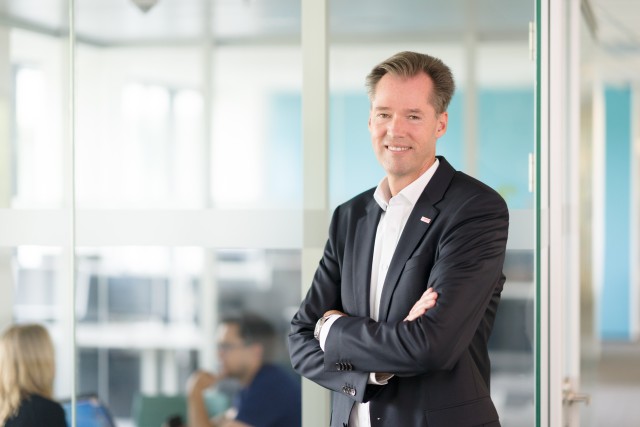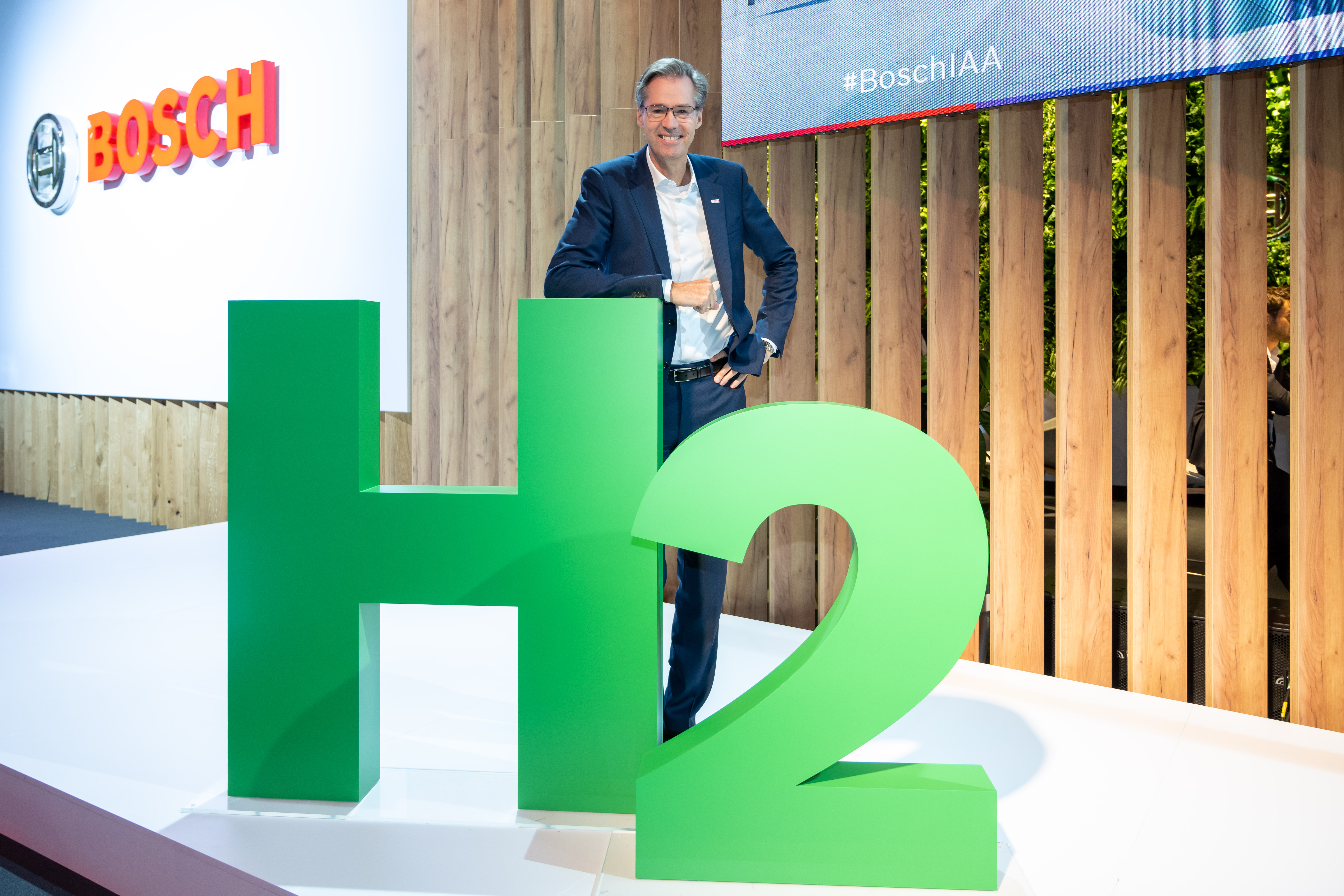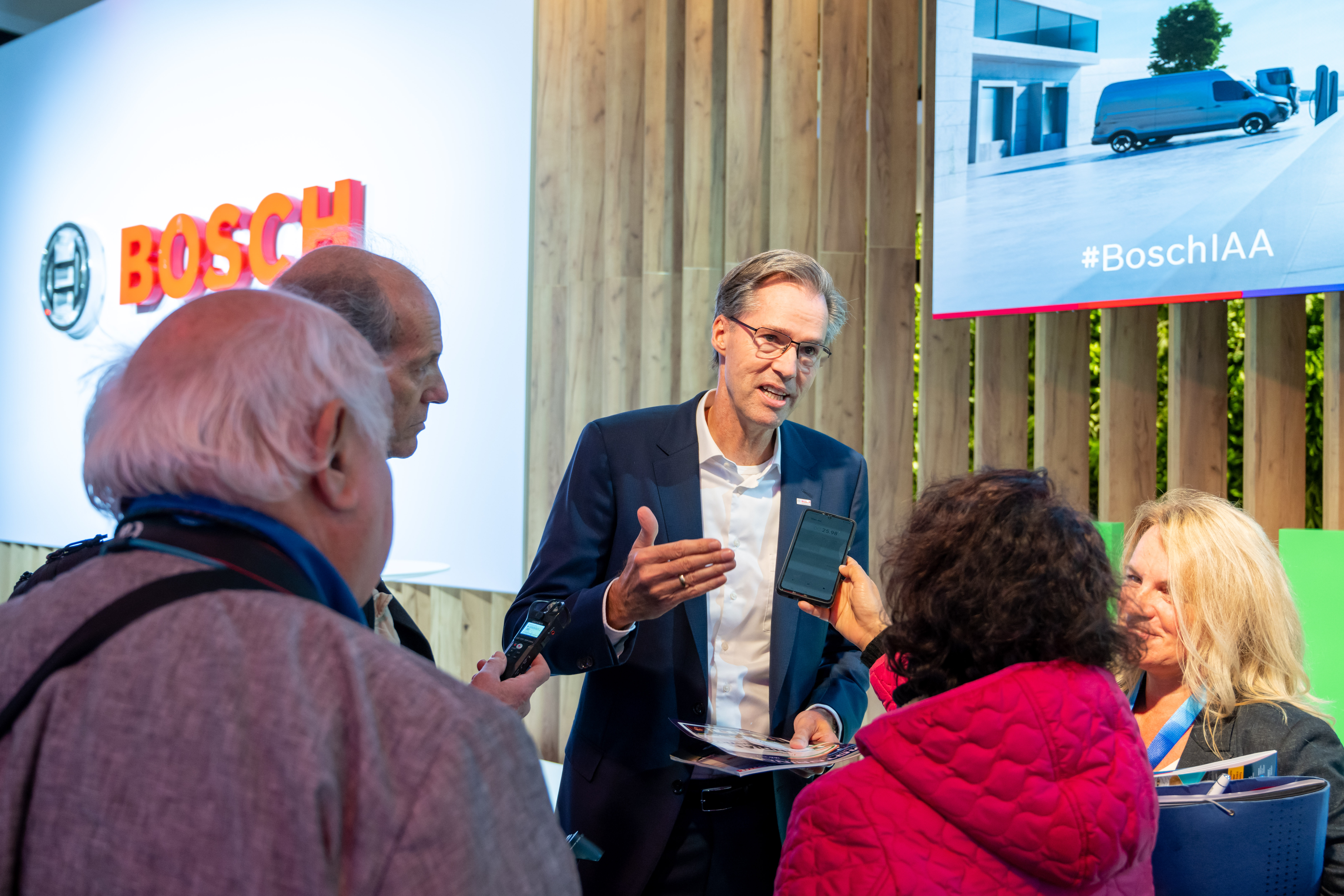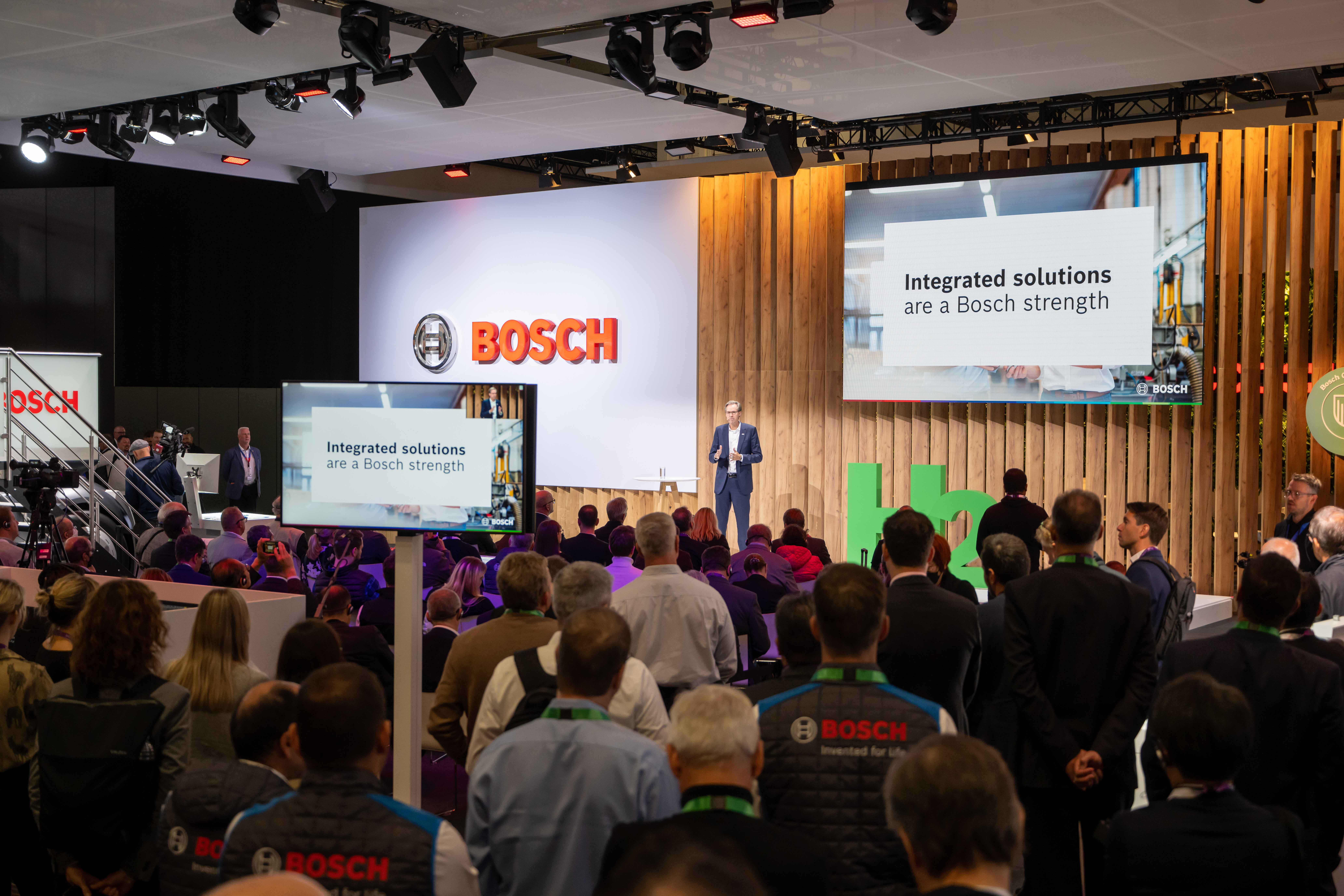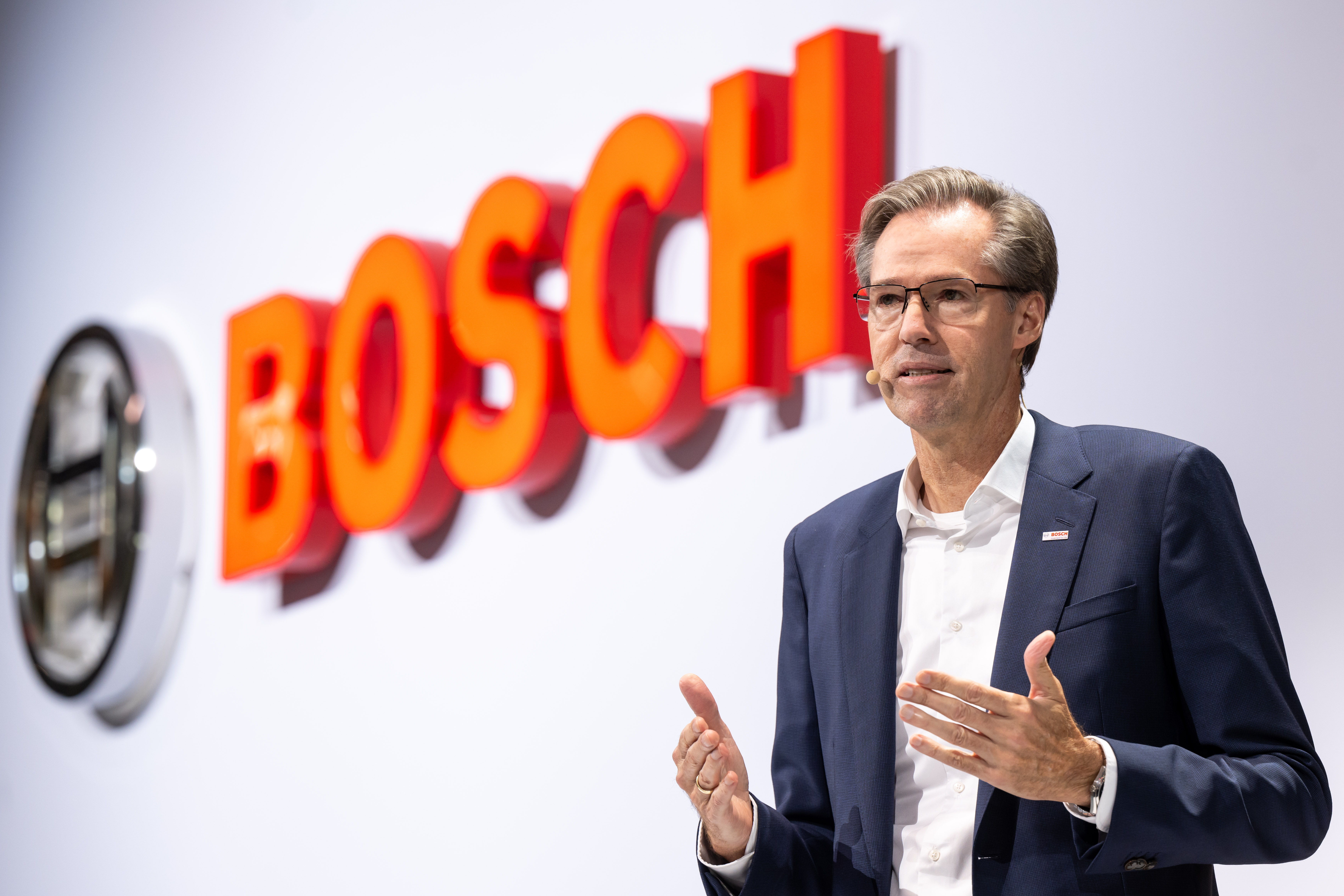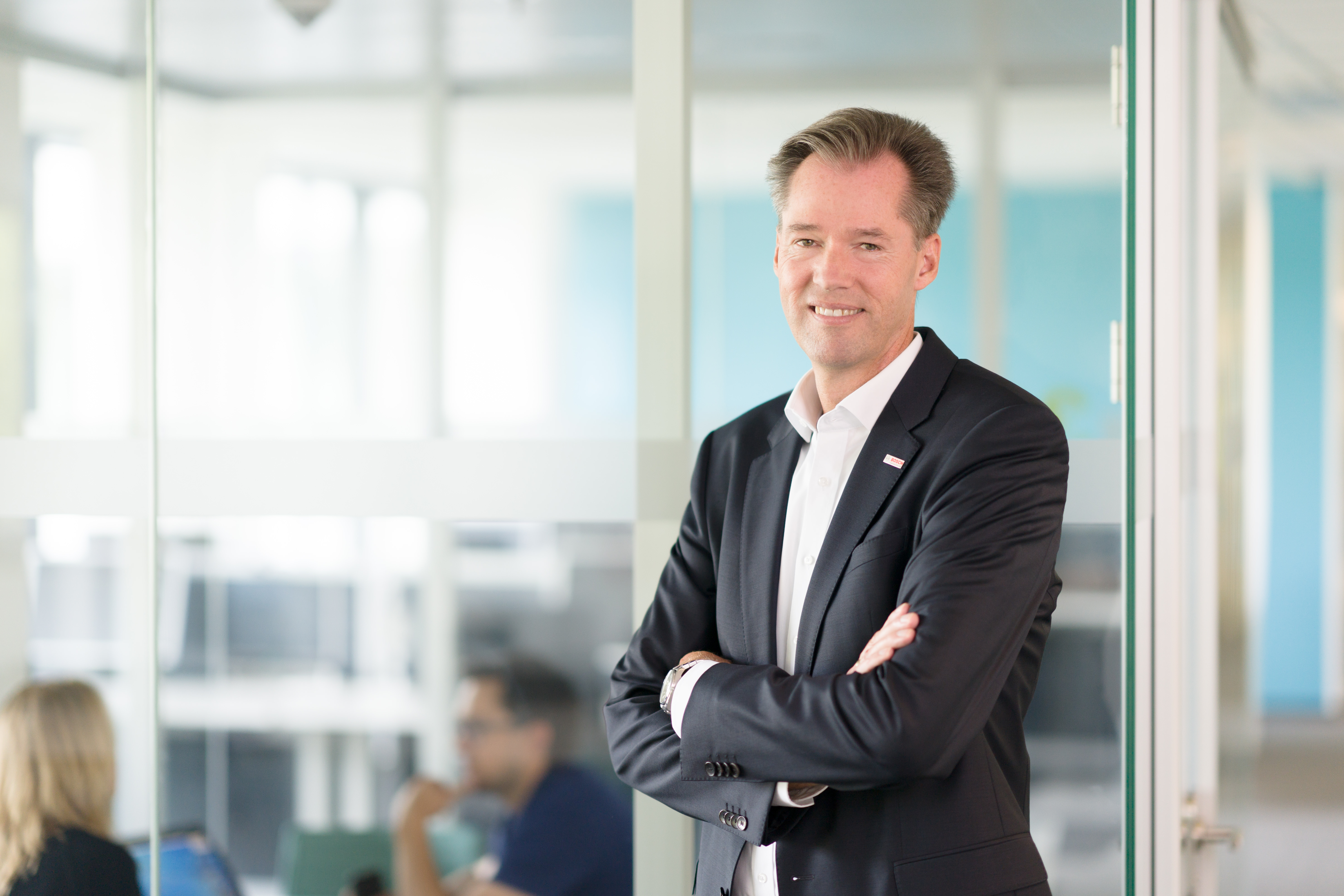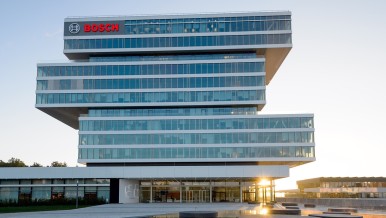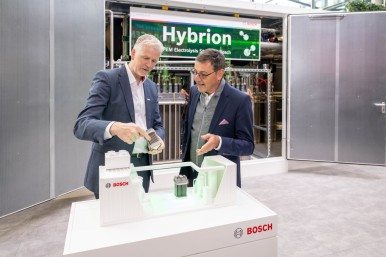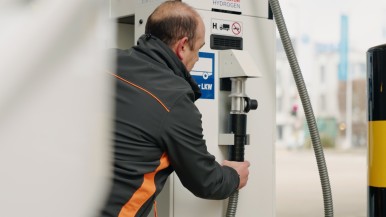Dr. Markus Heyn,
chairman of the Mobility Solutions business sector
of Robert Bosch GmbH,
at the IAA Transportation press conference
on September 19, 2022 in Hannover
Check against delivery.
Ladies and gentlemen,
Never has the future of commercial-vehicle development been so wide open as it is now. In this exciting time for our customers and engineers, I welcome you to Bosch at IAA Transportation. While electromobility is emerging as essentially the sole option for the future of the passenger car, we see several alternative powertrain systems for the trucks of tomorrow. In the name of climate action, freight transport is moving in different and, above all, more diverse directions. It’s true that diesel still has a longer life ahead of it in trucks than in passenger cars, especially outside Europe. But it is now being joined by three climate-neutral powertrain options: the battery, the fuel cell, and last but not least, the hydrogen engine. Bosch, like no other company, is developing all the powertrains for the trucks of tomorrow. Our goal is to have trucks no longer be a burden on the climate.
This is an ambitious goal, as global freight transport is expected to increase 40 percent by 2030, and even triple by 2050. It spurs economic growth, and that growth, in turn, moves it forward. So it is also the truck powertrain that will decide whether growth and climate action can be reconciled.
This is not the only issue currently affecting the logistics industry. There are four more challenges we are helping to solve:
- First, the driver shortage. Europe needs 400,000 truck drivers, so we’re teaching trucks to drive themselves. An automated truck will not only avoid accidents due to human error, but it will also pay for itself.
- Second, supply-chain difficulties around the world. Where are the goods, what is their condition? Our track-and-trace solution provides answers in real time with the help of sensors on the transport containers.
- Third, the lack of efficiency and security in goods transportation. More than one in three truck journeys is an empty run, and stolen freight causes more than eight billion euros in damage across Europe every year. One way to combat this is with logistics services based on connectivity in truck fleets.
- Fourth, the almost overwhelming variety of IT solutions for managing truck fleets. This makes it all the more important to bundle them on one platform. Bosch is introducing just such a platform with Amazon Web Services over the next few months.
More than ever, challenges like these call for expertise in software and the internet of things. That’s why we are looking beyond the hood in our work on the future of freight transport.
In all this, the economic environment remains difficult – the war in Ukraine, supply bottlenecks, and inflation, to name just a few issues. The energy crisis has recently worsened on the heels of considerable increases in the price of raw materials and semiconductors, and the entire industry is suffering as a result. That is why Bosch, too, must remain in dialogue with its automotive customers about fair compensation. So far this year, the sales revenue of our Mobility Solutions business sector grew by a good six percent after adjusting for exchange-rate effects. We generate one-fourth of our sales revenue from our commercial-vehicle technology business, ranging from vans to 40-ton trucks. This business in particular will experience a surge in growth over the course of the decade, primarily due to alternative powertrains such as fuel-cell technology.
Many paths lead to a climate-neutral powertrain – Bosch is pursuing all of them
But how is the market for these powertrains developing? Here we would do well to think in scenarios. It is, however, expected that by 2035, the share of commercial vehicles weighing six metric tons or more that run on diesel – a share that has dominated the market up to now – will fall to less than half. That’s still enough to keep pressing ahead with diesel development. And with synthetic fuels, diesel vehicles will also be carbon neutral to operate, meaning the existing fleet can play a part in climate action. Nevertheless, by the middle of the next decade, more than half of all new commercial vehicles will be electric, powered either by a battery or by hydrogen. A technology-neutral approach is particularly useful in commercial vehicles – depending on the application, route length, and vehicle weight, there will be more than one climate-neutral option for the truck powertrain.
With 3,400 engineers, Bosch is pursuing four development paths toward moving the commercial vehicle of tomorrow:
First, there’s diesel, which is becoming even more efficient with the new exhaust and CO₂ limits. Standards are rising in both China and the U.S. and Euro VII is coming to Europe, so this can once again become a driver of innovation. This makes it all the more important that emission specifications strive to reflect driving conditions that are as realistic as possible. We are forecasting strong demand growth for exhaust gas aftertreatment – sales of our Denoxtronic system are set to increase by ten percent as early as next year. CO₂ legislation will deliver certain economic advantages as well, and these will benefit freight forwarders directly, as less carbon dioxide requires greater efficiency in diesel.
- Our second development path is the battery-electric powertrain, which is taking up a growing slice of our order books. For example, we already have 30 major orders from commercial vehicle manufacturers in the world’s three key economic regions. Our strengths here include not only our components but our integrated solutions as well. Our advanced driving module is suitable for vans and combines e-axle, brakes, and steering. For trucks, we offer scalable electric motors adapted for use in conjunction with silicon carbide inverters. This combination yields an efficiency of up to 97 percent – an outstanding rate among electric powertrains for commercial vehicles.
- On the third development path, we are making great strides toward getting the fuel-cell electric powertrain ready for large-scale production. It can be seen at this IAA in a Nikola truck, for example, with Bosch on board. By the end of the year, 500 trucks equipped with our fuel-cell technology will be on the road; by 2025, the figure is expected to exceed 40,000. Our plan is to produce these systems worldwide close to where our customers are: for example, we will also manufacture fuel-cell stacks in Wuxi, China, and are investing 200 million euros for this purpose in Anderson, USA. The Bamberg plant in Germany should receive the green light for stack production sometime in the next few weeks. By the end of the decade, it should cost no more to operate a fuel-cell truck than a diesel. What is ecologically correct must not be economically incorrect – that’s how to do climate action right.
- And finally, we are working on a hydrogen engine. This engine can do everything a diesel engine can, but is virtually climate neutral. Taking a closer look, it fills a gap among CO₂-neutral powertrains. Although its efficiency is below that of the fuel cell at low and medium loads, it is above that level at full load. Its field of application will thus be heavy long-distance transport and especially agricultural and construction machinery. Our components feature in more than 100 technical trials in the three major economic regions. In India, we have already won our first major project. Here, too, we are making serious progress.
No way forward without infrastructure – two Bosch solutions
Yet there is one thing we must bear in mind, ladies and gentlemen: whatever climate-neutral powertrain technology we develop, it will catch on only if the appropriate infrastructure is in place. Without a comprehensive network of charge spots and hydrogen filling stations, only a small number of vehicles with alternative powertrains will be on our roads over the long term – and vice versa. A chicken-and-egg problem, if you will. Politics has a role to play here, but Bosch, too, is addressing both sides of the issue. We develop solutions not only for the vehicle but also for the infrastructure:
- For example, we are offering filling station operators a way to make a cost-effective entry into hydrogen technology. To this end, our subsidiary Bosch Rexroth has partnered with Maximator Hydrogen to develop a solution for compressing hydrogen for filling stations, storage tanks, and pipelines. This technology is expected to be on the market as early as next year, and eventually rolled out to 4,000 hydrogen filling stations by 2030.
- At the same time, we are developing a digital recharging and operating service for electrified commercial vehicle fleets. This service will launch next year also. We assume that commercial vehicles will be recharged mainly at privately owned spots, such as the depots of large fleets. The new Bosch service offers several features for this, including an energy management system that absorbs expensive load peaks when recharging a large number of vehicles. This solution is tailored especially to electromobility in logistics. Overall, the market for recharging commercial vehicles will grow 50 percent annually over the course of this decade.
Countering the driver shortage – trucks that drive themselves
We need to rethink freight transport in every respect – not only what moves it, but also how it moves. Automated driving is coming, due in part to the acute driver shortage, and nowhere does automated driving make more economic sense than in commercial vehicles. Bosch is working apace to teach trucks to drive with European technology on European roads. We have just acquired the British startup Five, a company that will further accelerate our software development with its cloud-based testing platform. In any case, it is the software that will essentially determine the automated driving characteristics in commercial vehicles. To put it another way, the “software-defined truck” is coming. This is an area where Bosch can play to its strengths: half the R&D associates in our Mobility Solutions business sector are software engineers.
Before this decade is out, our technology will allow highly automated trucks to drive on freeways. Our first step will be to implement driverless operation between two motorway service areas, followed by automated shuttle service between two logistics depots. We are working on the necessary solutions with more than 1,100 engineers, and have already put three key conditions in place:
- First, we have an ECU for automated driving – with a good 100 times the computing power of one for driver assistance. We have developed a prototype that will serve as the basis for our driving-strategy software and for the evaluation of sensor data using artificial intelligence.
- Second, we are making the electronics architecture in future trucks significantly more powerful. Bosch will be putting an appropriate vehicle computer into large-scale production at a European truck manufacturer by the middle of the decade.
- Third, at this IAA we are presenting two new steering systems that enable highly automated driving. One is purely electric, the other electrohydraulic. We have customers for them not just in Europe but also in China and the U.S. In addition, we already have an electrohydraulic steering system on the market that enables commercial vehicles to stay in their lane automatically. We are seeing growth of some 40 percent annually with this alone.
Finally, Bosch is very much on track in driver assistance. Propelling our efforts here are the legal requirements for preventing road accidents with commercial vehicles. In Europe, for example, turn assist systems will become mandatory in new trucks from 2024 onward. This will provide a boost for the corner radar sensor business in trucks. In the process, the market will grow by 40 percent over the next few years, Bosch by almost 60 percent.
Overview of multiple services – the launch of the logistics platform
More security, more efficiency – both are ultimately driven by the connectivity of freight transport. With the connectivity control unit, or CCU for short, we are laying the essential technical groundwork for trucks to become part of the internet. The CCU has long been more than just a toll device; it enables software updates, predictive diagnostics, and last but not least, logistics services. Our business with CCUs is growing by 25 percent, the market by ten percent. Here, too, we are achieving above-average growth.
When it comes to connectivity, Bosch can leverage twice the expertise: in the truck itself, but also in the internet of things. In this area, we are more than a hardware supplier; we are also directly pushing ahead with the logistics services business. To give you two examples:
- First, logistics monitoring: Bosch service centers monitor the condition of critical or even medically vital goods around the clock – between 30,000 and 40,000 high-value truckloads annually. During the coronavirus pandemic, we also took on the monitoring of vaccine shipments.
- Second, secure truck parking: Europe is lacking 400,000 secure truck parking spaces. Bosch offers 100 suitable areas along the highways in eleven countries. This means that secure parking spaces can be conveniently booked on our platform; truck drivers don’t have to frantically search for them every evening. Demand is on the rise, with bookings tripling in 2021 alone. In the future, our secure parking spaces will include overnight charging, too – solving two problems of freight traffic at once.
Given everything we do as a provider of logistics services, we also offer a platform that bundles such services. From our point of view, this is crucial for realizing the practical benefit of digital services under time and cost pressure. Until now, fleet operators have had to deal with a large number of solutions that exist independently of one another, i.e. they have no common pool of data. Integrating these solutions delivers a boost in efficiency. This is exactly what the new platform from Bosch and Amazon Web Services offers: the Logistics Operating System, or L.OS for short. We will be launching it in India within the next few weeks and then in Europe and the U.S. at the beginning of next year. Bosch supplies more than climate-neutral powertrains; with our software solutions, we are also creating new movement in freight transport. All this can be seen here at our booth. I look forward to welcoming you there!

